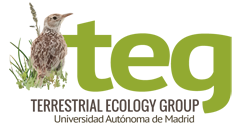
UAM. Dpto. Ecología
Carretera de Colmenar km.15
C/ Darwin, 2 (C111b)
Madrid 28049, España
Tel: 914973639
E-mail: javier.seoane (at) uam.es
http://www.uam.es/javier.seoane
I am pretty much curious about everything in wildlife biology, particularly when birds and mountains are involved. I obtained my Ph.D. in 2003 with a study on the then young subfield of species distribution models at the Doñana Biological Station (Seville, Spain). Since then, my main research line have focused on the environmental and biotic factors that determine the distribution and abundance of species, but I have also assessed monitoring protocols, statistical and modeling methodologies. More recently, I have been attracted to community ecology, studying assemblages of arthopods, fish, birds and mammals.
I am currently a permanent member of the Department of Ecology at the Autonomous University of Madrid (Spain), where I teach a variety of subjects. There I am fond of introducing ecology to biology undergraduates who do not always appreciate at first sight this kind of biology, and to teach specialized statistics to biologists that usually do not love numbers. In order to do that, I increasingly rely on ‘modern’ teaching methods (basically meaning active and fun).
Since 2017 I am the editor-in-chiefsoy of Ardeola: International Journal of Ornithology, one of the few scientific journals in the natural sciences based on Spain that have maked its way into the JCR.
A bunch of papers to describe my work
Marín-Enríquez, E., Seoane, J., Muhlia-Melo, A. 2018. Environmental modeling of occurrence of dolphinfish (Coryphaena spp.) in the Pacific Ocean off Mexico reveals seasonality in abundance, hot spots and migration pattern Fisheries Oceanography, 27: 28-40
Bastianelli, G., Tavecchia, G., Meléndez, L., Seoane, J., Obeso, J., Laiolo, P. 2017. Surviving at high elevations: an inter‑ and intra‑specific analysis in a mountain bird community. Oecologia, 184: 293-303
Laiolo, P., Seoane, J., Obeso, J.R., Illera, J.C. 2017. Ecological divergence among young lineages favours sympatry, but convergence among old ones allows coexistence in syntopy. Global Ecology and Biogeography, 26:601-608
Seoane, J., Laiolo, P., Obeso, J.R. 2017. Abundance leads to more species, particularly in complex habitats: a test of the increased population size hypotheses in bird communities. Journal of Biogeography, 44:556-566.
Laiolo, P., Seoane, J., Illera, J.C., Bastianelli, G., Carrascal, L.M., Obeso, J.R. 2015. The evolutionary convergence of avian lifestyles and their constrained coevolution with species’ ecological niche Proceedings of the Royal Society B. Biological Sciences, 282:20151808
Seoane, J., Villén-Pérez, S., Carrascal, L.M. 2013. Environmental determinants of seasonal changes in bird diversity of Mediterranean oakwoods. Ecological Research, 28:435-445
Carrascal, L. M., Cayuela, L., Palomino, D., S., Seoane, J. 2012. What species-specific traits make a bird a better surrogate of native species richness? A test with insular avifauna. Biological Conservation, 152:204-211
You may find a complete list of publications in:
ResearchGate: http://www.researchgate.net/profile/Javier_Seoane/
ResearcherID: http://www.researcherid.com/rid/B-6833-2008
Google Académico: http://scholar.google.com/citations?user=mfXM3TAAAAAJ

